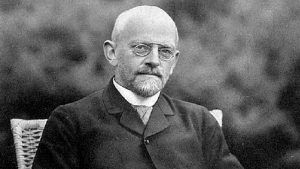
Between 29 June and 7 July 1915, at the invitation of David Hilbert, Einstein gave a series of lectures in Göttingen on General Relativity. At that time, Hilbert was interested in a mathematical formulation for physics that would account for both gravitation and the electromagnetic field – understood in the manner of Gustav Mie (1868-1957), where matter was conceived as a kind of accumulation of the electromagnetic field in areas of very high density. Einstein found his visit to Göttingen very stimulating, especially because of the attention that Hilbert had paid to him during his lectures, and he wrote to several friends: “In Göttingen I had the great pleasure of seeing that everything was being understood down to the last detail. I am completely delighted with Hilbert!” The ideas that Einstein presented in his lectures, both the physical and the mathematical ones, were very suggestive for Hilbert… perhaps even too much, because his greater mathematical knowledge and skill put him in a very good position to beat Einstein to the final formulation of the laws of general relativity. And when the same or similar discoveries are made independently in science –which is not uncommon– they inevitably generate a certain historical debate, the intensity of which often parallels the importance of the discovery. This is certainly the case with Einstein and Hilbert.

The two men’s race towards the goal of finding the mathematical equations of gravitation saw a very intense and exciting final sprint between 4 and 25 November 1915. In the four meetings that the Prussian Academy of Sciences held on Thursdays of that month – i.e. on 4, 11, 18 and 25 November – Einstein presented up to three more or less different theories, and it was in the session of 25 November 1915 that the definitive equations of general relativity appeared for the first time; Einstein would later refer ironically to a friend about this comedy of errors: “Unfortunately, the final errors of this contest I have immortalised in the papers published by the Academy which I will soon send to you”. In the first of these papers, Einstein said: “I have returned to the requirement of general covariance for the field equations, a requirement from which I had first and with great regret departed three years ago when I worked with my friend Marcel Grossmann. In fact, at that time we had already come very close to the solution which I give to the problem in what follows”. General covariance amounts to taking the requirement of general relativity to its ultimate consequences: the laws of physics must be expressed in the same way whatever the state of motion of the observer. And to achieve this general covariance Einstein had to rely on the mathematical apparatus based on the Riemannian and Ricci-Levi Civita tensors, which his friend Grossmann had taught him. In a way, this meant that, in his final sprint, Einstein had chosen to be guided by the greater generality of mathematics.
However, the theory he presented on the 4th was not general covariant, so he submitted a new paper to the Academy on 11 November, where the equations were already general covariant. It turns out that these equations are the ones he had rejected when he worked with Grossmann, misinterpreting that Newton’s mechanics could not be obtained from his theory in the limiting case of matter concentrations not excessively large and moving at speeds small compared to the speed of light. With this new version Einstein achieved a success he had been seeking since 1907: to explain the anomalous motion of Mercury’s perihelion (already discussed in a previous entry). However, the theory still had a flaw in that it implied the cancellation of the matter field, something that did not seem to correspond to reality. In a few days, however, Einstein found a way to slightly modify the equations by eliminating this drawback and without losing the general covariance, nor the explanation for the motion of Mercury’s perihelion. This was the final version that he presented to the Academy on 25 November. By his own admission, it was the culmination of weeks of such intense and exhausting work that “I often forgot to eat”. But it had been worth it, and in several letters during those days he commented to friends and acquaintances: “The theory is of incomparable beauty”; and also: “The most valuable discovery of my life”; and even: “My best dreams have come true”.
But by 25 November, when Einstein presented his equations, David Hilbert had already reached the finish line five days earlier. Specifically, on 20 November 1915, he had presented a paper to the Göttingen Academy of Sciences in which he axiomatically formulated the laws of physics for both electromagnetism and gravitation – and for which Hilbert chose the unmistakable title The Foundations of Physics. His paper was published a few weeks later, and in it the formulas for gravitation are identical to those that Einstein presented on 25 November for his General Theory of Relativity – published on 2 December.
With all this in mind, could it be said that Hilbert was ahead of Einstein in the formulation of general relativity? The answer will be in my next post on the Basic Wardrobe.
References
A.J. Durán, El universo sobre nosotros, Crítica, Barcelona, 2015.

Indeed, I would claim that others (D. Hilbert and others) should have been equally credited for the realization of these new concepts in Physics as was Einstein, if not more. Two related consequences support my conclusion. One, that the extensive and unprecedented media coverage that Einstein received crediting him with the above findings at the expense of all the others (Lorentz, Pointcare, Hilbert etc…) belies intentional cover-up and an orchestrated attempt in highlighting Einstein’s role as the sole contributor worthy of mention. Secondly, the end results of wars almost always dictate their own history. At least, for a while, one cannot fool all the people all the time.